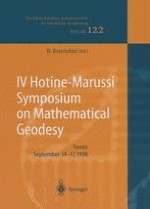2001 | OriginalPaper | Chapter
The Molodensky Scalar Boundary Value Problem in Spherical Coordinates: a New Result
Authors : Jesús Otero, Fernando Sansò
Published in: IV Hotine-Marussi Symposium on Mathematical Geodesy
Publisher: Springer Berlin Heidelberg
Included in: Professional Book Archive
Activate our intelligent search to find suitable subject content or patents.
Select sections of text to find matching patents with Artificial Intelligence. powered by
Select sections of text to find additional relevant content using AI-assisted search. powered by
The theory and analysis of free boundary value problems has attained a certain popularity in Geodesy in the last 20 years, being considered as a sort of reference theory providing a sound scientific background to the problem of determining the figure of the earth and its gravity field. In this framework an effort has been done to come to a solution of the most relevant problem, namely the so-called scalar geodetic boundary value problem, under the most general conditions of regularity of the boundary values. In fact the basic theorem proven here guarantees a solution for the (modified) Molodensky scalar boundary value problem under the conditions that (on the boundary)the gravity belongs to H α and the gravitational potential to H1+α.One of the basic tools to get this result has been the intermediate Schauder estimates for oblique derivative problems obtained by G.M.Lieberman. The drawback of what we have proved is as always the use of existence theorems in the small, which do not say much about how ”close” should be the data to the reference field in order to guarantee existence and uniqueness of solution. Furthermore, as in many other works in this field, the result is obtained here in the so-called spherical approximation for the reference field and one could think that a better result could be achieved by working with an ellipsoidal approximation for the reference field; this could be a line of research worth some effort in future.
